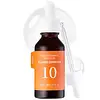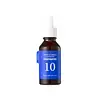What's inside
What's inside
 Key Ingredients
Key Ingredients

 Benefits
Benefits

 Concerns
Concerns

 Ingredients Side-by-side
Ingredients Side-by-side

Water
Skin ConditioningButylene Glycol
HumectantBetaine
HumectantNiacinamide
Smoothing1,2-Hexanediol
Skin ConditioningPolyglyceryl-4 Caprate
EmulsifyingMethyl Gluceth-20
HumectantLactobacillus/Lac Ferment
Skin ConditioningHydroxyethyl Acrylate/Sodium Acryloyldimethyl Taurate Copolymer
Emulsion StabilisingSqualane
EmollientCarbomer
Emulsion StabilisingDimethicone
EmollientTromethamine
BufferingAdenosine
Skin ConditioningSodium Hyaluronate
HumectantDipropylene Glycol
HumectantSodium Phytate
Xanthan Gum
EmulsifyingPogostemon Cablin Leaf Oil
MaskingCitrus Nobilis Peel Oil
MaskingCitrus Aurantium Dulcis Peel Oil
MaskingWater, Butylene Glycol, Betaine, Niacinamide, 1,2-Hexanediol, Polyglyceryl-4 Caprate, Methyl Gluceth-20, Lactobacillus/Lac Ferment, Hydroxyethyl Acrylate/Sodium Acryloyldimethyl Taurate Copolymer, Squalane, Carbomer, Dimethicone, Tromethamine, Adenosine, Sodium Hyaluronate, Dipropylene Glycol, Sodium Phytate, Xanthan Gum, Pogostemon Cablin Leaf Oil, Citrus Nobilis Peel Oil, Citrus Aurantium Dulcis Peel Oil
Water
Skin ConditioningPropanediol
SolventButylene Glycol
HumectantGlycerin
Humectant1,2-Hexanediol
Skin ConditioningGlycyrrhiza Glabra Root Extract
BleachingGlycereth-26
HumectantAmmonium Acryloyldimethyltaurate/Vp Copolymer
Betaine
HumectantCaprylyl/Capryl Glucoside
CleansingPolyglyceryl-10 Laurate
Skin ConditioningDipropylene Glycol
HumectantChamomilla Recutita Flower Extract
MaskingSodium Hyaluronate
HumectantXanthan Gum
EmulsifyingDisodium EDTA
Polyglyceryl-10 Oleate
Skin ConditioningJuniperus Mexicana Oil
MaskingRosa Damascena Flower Oil
MaskingDipotassium Glycyrrhizate
HumectantPogostemon Cablin Leaf Oil
MaskingVetiveria Zizanoides Root Oil
MaskingGuaiazulene
AntimicrobialBeta-Glucan
Skin ConditioningPolyglutamic Acid
Skin ConditioningWater, Propanediol, Butylene Glycol, Glycerin, 1,2-Hexanediol, Glycyrrhiza Glabra Root Extract, Glycereth-26, Ammonium Acryloyldimethyltaurate/Vp Copolymer, Betaine, Caprylyl/Capryl Glucoside, Polyglyceryl-10 Laurate, Dipropylene Glycol, Chamomilla Recutita Flower Extract, Sodium Hyaluronate, Xanthan Gum, Disodium EDTA, Polyglyceryl-10 Oleate, Juniperus Mexicana Oil, Rosa Damascena Flower Oil, Dipotassium Glycyrrhizate, Pogostemon Cablin Leaf Oil, Vetiveria Zizanoides Root Oil, Guaiazulene, Beta-Glucan, Polyglutamic Acid
Ingredients Explained
These ingredients are found in both products.
Ingredients higher up in an ingredient list are typically present in a larger amount.
1,2-Hexanediol is a synthetic liquid and another multi-functional powerhouse.
It is a:
- Humectant, drawing moisture into the skin
- Emollient, helping to soften skin
- Solvent, dispersing and stabilizing formulas
- Preservative booster, enhancing the antimicrobial activity of other preservatives
Betaine is a common humectant (a substance that promotes retention of moisture). It's known to be gentle on the skin and can help balance hydration.
This ingredient is best for improving hydration and soothing irritated skin. Studies also show it helps even out skin tone.
Fun fact: Betaine is naturally created in the skin and body. The kind found within cosmetic products can be either plant-derived or synthetic.
Another name for betaine is trimethylglycine.
Learn more about BetaineButylene Glycol (or BG) is used within cosmetic products for a few different reasons:
Overall, Butylene Glycol is a safe and well-rounded ingredient that works well with other ingredients.
Though this ingredient works well with most skin types, some people with sensitive skin may experience a reaction such as allergic rashes, closed comedones, or itchiness.
Learn more about Butylene GlycolDipropylene Glycol is a synthetically created humectant, stabilizer, and solvent.
This ingredient helps:
Dipropylene glycol is technically an alcohol, but it belongs to the glycol family (often considered part of the ‘good’ alcohols). This means it is hydrating and gentle on skin unlike drying solvent alcohols like denatured alcohol.
As a masking agent, Dipropylene Glycol can be used to cover the smell of other ingredients. However, it does not have a scent.
Studies show Dipropylene Glycol is considered safe to use in skincare.
Learn more about Dipropylene GlycolThis ingredient is commonly known as Patchouli oil.
Patchouli exhibits slight antibacterial and antifungal activity from its patchoulol and alpha-patchoulene content.
However, it also contains known skin-irritating fragrances. A study from 2015 found limonene and camphor as active components of this ingredient.
Limonene and camphor are both known EU allergens.
Learn more about Pogostemon Cablin Leaf OilSodium Hyaluronate is hyaluronic acid's salt form. It is commonly derived from the sodium salt of hyaluronic acid.
Like hyaluronic acid, it is great at holding water and acts as a humectant. This makes it a great skin hydrating ingredient.
Sodium Hyaluronate is naturally occurring in our bodies and is mostly found in eye fluid and joints.
These are some other common types of Hyaluronic Acid:
Learn more about Sodium HyaluronateWater. It's the most common cosmetic ingredient of all. You'll usually see it at the top of ingredient lists, meaning that it makes up the largest part of the product.
So why is it so popular? Water most often acts as a solvent - this means that it helps dissolve other ingredients into the formulation.
You'll also recognize water as that liquid we all need to stay alive. If you see this, drink a glass of water. Stay hydrated!
Learn more about WaterXanthan gum is used as a stabilizer and thickener within cosmetic products. It helps give products a sticky, thick feeling - preventing them from being too runny.
On the technical side of things, xanthan gum is a polysaccharide - a combination consisting of multiple sugar molecules bonded together.
Xanthan gum is a pretty common and great ingredient. It is a natural, non-toxic, non-irritating ingredient that is also commonly used in food products.
Learn more about Xanthan Gum